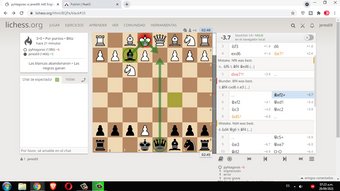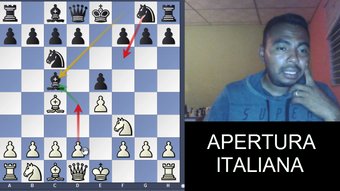Aplicando las tácticas del siglo 17.|| Applying the tactics of the 17th century.
4
About :
Hola amigos, hoy hablaremos y aplicaremos las técnicas de los años 1700, y para ser sincero esas técnicas no sirven hoy en día, ni siquiera con los jugadores muy principiantes. Dice Lasker:"Aún cuando un ataque no puede llevarse a cabo con éxito, sólo el lograr una posición desde donde en un momento oportuno pueda emprenderse el ataque, habrá resultado una gran ventaja si se mantiene la iniciativa. La amenaza constante pone al adversario en la necesidad de estar alerta y le obliga a atar ciertas fuerzas en la defensa, debilitándose. Además la tensión inherente causa un esfuerzo nervioso que a menudo lleva a cometer errores".
Cuando uno de los bandos conduce su juego en forma activa, casi cada una de sus jugadas incluye amenazas y el tema de la defensa es descubrir y rechazar tales amenazas. Pero no alcanza con ello: hay que saber elegir el mejor camino entre las diversas posibilidades defensivas.
Todo lo que ayude no sólo a defender sino además a mejorar el juego de conjunto debe ser considerado primero. Hay que desconfiar de las «jugadas naturales», o sea, que parecen obvias.
Entonces la técnica de la defensa era incipiente. Sólo intuitivamente podía considerarse que debe ser económica, tanto en material como en tiempo, porque permite organizar mejor una contraofensiva. Aunque sí sabían que no siempre la prevención inmediata contra las amenazas es lo exacto, tal vez porque ello parece ser un fino derivado de la celada.
La defensa activa o contraataque era utilizada en exceso. Hoy todo el mundo sabe que a veces no puede ensayarse sino después de cambiar alguna pieza rival y de mejorar la posición.
Todo esto encierra un elemento psicológico muy importante. En ocasiones, el atacante se descuida en su propia defensa y en su optimismo pasa por alto golpes de contraataque, como un sacrificio que plantea una amenaza muy fuerte o un simple jaque que encuentra desprevenido al rey.
Now in English.
Hello friends, today we will talk and apply the techniques of the 1700s, and to be honest those techniques do not work today, not even with very beginner players. Lasker says:"Even when an attack cannot be carried out successfully, only the achievement of a position from which at an opportune moment the attack can be undertaken, will have been a great advantage if the initiative is maintained. The constant threat puts the adversary in the need to be alert and forces him to bind certain forces in defense, weakening himself. Furthermore, the inherent tension causes a nervous effort that often leads to making mistakes."
When one side actively conducts its game, almost every one of its moves includes threats, and the issue of defense is to discover and repel such threats. But that is not enough: you have to know how to choose the best path among the various defensive possibilities.
Everything that helps not only defend but also improve the team's game should be considered first. We must be wary of "natural moves", that is, those that seem obvious.
Then the defense technique was incipient. Only intuitively could it be considered that it must be economical, both in material and time, because it allows a counteroffensive to be better organized. Although they did know that immediate prevention against threats is not always the right thing to do, perhaps because it seems to be a fine derivative of the trap.
Active defense or counterattack was used excessively. Today everyone knows that sometimes you cannot rehearse until after changing a rival piece and improving the position.
All this contains a very important psychological element. Sometimes the attacker becomes careless in his own defense and in his optimism overlooks counterattacking blows, such as a sacrifice that poses a very strong threat or a simple check that catches the king off guard.

Herramientas usadas para la realización de mi material.
Imágenes usadas: Son capturas de pantalla sacadas durante la edición del vídeo.
Editor de imagen: Photoshop Cs 6.
Editor de vídeo: Camtasia Studio 8.
Cámara utilizada: Teléfono Samsumg A02.
El separador de texto lo hice usando el logo de hive, la silueta de las piezas están entre las herramientas del photoshop.

Tools used for the realization of this material.
- Images used: Screenshots taken during the editing of the video.
- Image editor: Photoshop Cs 6.
- Video editor: Camtasia Studio 8.
- Camera used: Samsumg A02 phone.

Tags :
Their limit for today is $0!





























Comments:
Reply:
To comment on this video please connect a HIVE account to your profile: Connect HIVE Account